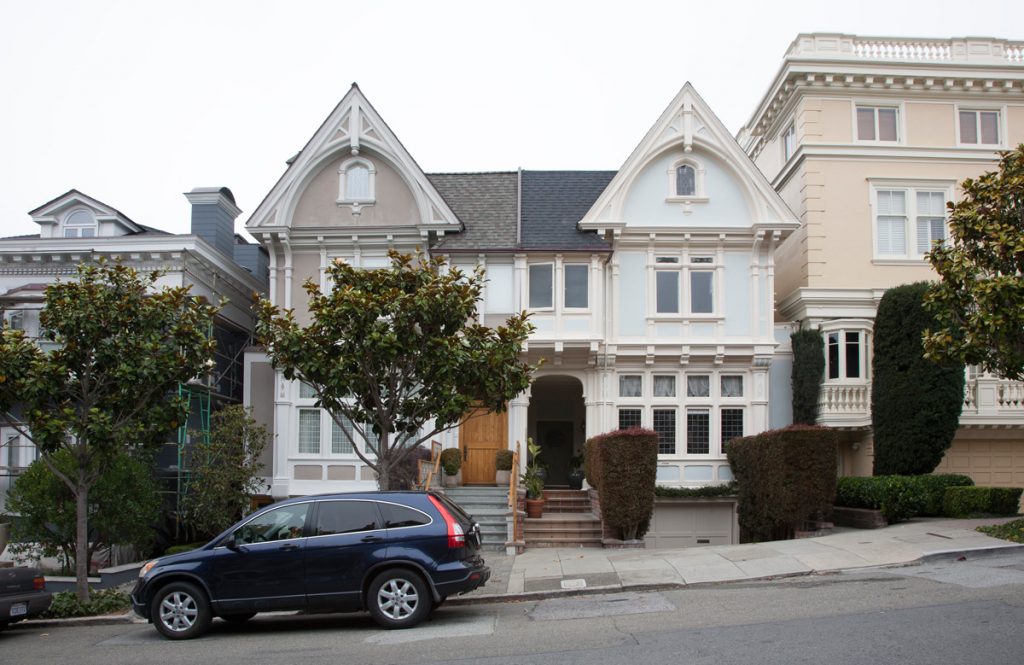LANDMARKS | BRIDGET MALEY
The two English-inspired Tudor style townhouses at 3356 and 3362 Jackson Street are a perfectly matched set. Built for George and Ruth Beveridge in 1898, this charming Presidio Heights ensemble was designed by the short-lived architectural partnership of Newton J. Tharp and Edward L. Holmes.
George Beveridge, a successful miner who made considerable investments in Mexico, married Ruth Coffin in 1895. Two years later, he purchased the double lot on Jackson Street and commissioned Tharp and Holmes to design two abutting, well-appointed townhouses — one for the Beveridges to occupy and the other to sell or rent.
The household, settled in at 3362 Jackson, at first consisted of Ruth and George Beveridge; their daughter, Frances; Mrs. R.J. Coffin, Ruth’s mother; and Kitty O’Leary, the Beveridges’ Irish nanny.
As Pacific Heights expanded westward into Presidio Heights between 1895 and 1910, significant homes and apartment buildings were designed and built in the vicinity, including:
• Ernest Coxhead’s hillside houses in the 3200 block of Pacific Avenue (1902-1904)
• The shingled apartments at 100 Walnut Street by Walter Mathews (1903)
• Three shingled houses by Albert Farr in the 3300 block of Pacific for Edward Bullard and brothers Robert and Hugh Postlethwaite (1903)
• Julia Morgan’s 3377 Pacific (1908)
• Bernard Maybeck’s Roos House at Jackson and Locust (1909).
The twin Tudor-themed townhouses are an early contribution to this burgeoning residential enclave that attracted the city’s best architects catering to some of its wealthiest citizens. The 1905 Sanborn Map indicates a center cluster of houses in the block bounded by Jackson, Walnut, Laurel and Pacific, including Tharp’s twin townhouses and Farr’s three shingled gems for Bullard and the Postlethwaite brothers. In an iconic photograph of Farr’s shingled Presidio wall grouping, the westernmost of the two duplexes designed by Tharp and Holmes appears in the background.
Tharp, not as well known as some of his contemporaries, was an Iowan who received architectural training in Chicago, then studied in Paris and traveled in Europe before apprenticing in Chicago and New York. He settled in San Francisco in 1889, working in the office of Edward R. Swain. A Chronicle announcement on March 12, 1897 noted: “Newton J. Tharp, the designer and draughtsman, has gone to Europe and will be absent from eight to ten months. The cathedral towns of France and England and the triumphs of the Renaissance in Italy will be the special objects of his study.”
Shortly after Tharp’s return, he began designing the attractive townhouses on Jackson, no doubt inspired by English cottages viewed during his travels. The January 1, 1898, Chronicle reported: “George K. Beveridge will soon commence the construction of two residences on the north side of Jackson Street, between Walnut and Laurel, on plans by Tharp & Holmes. They will cost about $11,000.”
Tharp’s brief partnership with Holmes appears to have ended in the summer of 1901 when the Chronicle reported that Tharp had “retained the old offices of the former Tharp & Holmes, and has considerable work under way.” One of the architect’s best known commissions, the Dewey Monument in Union Square, commemorates Admiral Dewey’s 1898 victory at Manila Bay. Tharp’s other projects include a Stanford University fraternity house for Sigma Alpha Epsilon and at least two other Presidio Heights residences, one for Wallace Bradford at the northwest corner of Clay and Maple, and one for Belle F. Lee on the south side of Jackson west of Locust.
Tharp was also a writer and critic, publishing a long, scathing article in the December 1900 issue of Overland Monthly titled “What Bad There Is and Good There Might Be in Inexpensive Architecture.” He lamented the buildings of the day, and bemoaned “how much better they would look divested of all their false work and milled ornament,” and instead depended upon “the rustic boarding with well proportioned openings and a logical roofing for an architectural effect.” His Jackson Street townhouses for the Beveridges illustrate this new anti-Victorian architecture embraced by many Bay Area architects.
After the destruction of the 1906 earthquake and fire, Tharp was appointed city architect. Over the next few years, he was responsible for well-designed firehouses and schools, as well as Clarendon Hall at Laguna Honda Hospital. Active in the arts and the business community, Tharp was a member of the Bohemian Club. He married Laura Hanna of Los Angeles in 1892.
While visiting New York to inspect and study newly designed schools and hospitals, Tharp became sick and died quite unexpectedly. The May 13, 1909, Chronicle in a special dispatch from New York recounted that Tharp “died at the Hotel Knickerbacker early this morning. He was taken suddenly ill last week with an attack of grip, but his ailment was not considered serious until yesterday, when heart failure developed.”
The Beveridges lived at 3362 Jackson until about 1905, when they moved to a larger residence at 43 Presidio Avenue. A subsequent resident was Frederick Patek, a butcher. By 1925, and until his death in 1948, architect Samuel L. Hyman owned the house. Hyman was a prolific architect, with many commissions within San Francisco’s vibrant Jewish community, including the seven-story Mt. Zion nurse’s building (1925, demolished); the Hebrew Home for the Aged (1923); the Eureka Benevolent Society Building (1930-31, altered) and the Sinai Memorial Chapel (1937). Hyman’s neighbor, developer Laurence A. Myers at 3434 Jackson, was often his client.
The easternmost of the two townhouses, 3356 Jackson, was occupied by James Ellis Tucker, a financial agent, from 1899 to about 1902. Later the townhouse was home to Andrew Carrigan, then Emmanuel Lederman, a real estate agent. For a long time, it was owned by Howard Salz, a tanner with operations in San Francisco, Benicia and Santa Cruz.
Filed under: Bridget Maley, Landmarks






